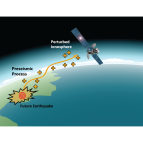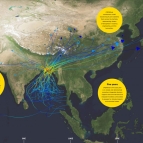Motion Under Rubble Measured Using Radar

Lincoln Laboratory's Motion Under Rubble Measured Using Radar (MURMUR) technology was created to help rescue teams save lives more efficiently in complex disaster environments. The technology is a remote-controlled system mounted on an unmanned ground or air vehicle that uses radar to peer through walls, rubble, and debris to detect the motion of a human breathing. Search-and-rescue personnel can then see these detections in real time on a mobile device.
To make these detections, MURMUR uses radar technology operating at low frequencies that allow it to penetrate a variety of materials, including concrete, drywall, wood, and rebar. This radar generates and transmits RF energy that radiates throughout the scene. Given the water content of the human body and the motion generated by breathing, humans can reflect this RF energy back to the radar's receiver. The receiver digitizes this signal for processing with both classical signal processing techniques and novel machine learning algorithms, allowing us to glean specific information about a detection. We can determine the range in depth at which someone is buried beneath certain types of rubble and debris, the rate at which the buried person is breathing, and whether their breathing is shallow or strong. This information allows search and rescue to determine who is most in need of care and who can quickly be rescued. Our goal with MURMUR is to help reduce the risk to rescue personnel and search animals in dangerous search efforts and enable a timely recovery of survivors.



